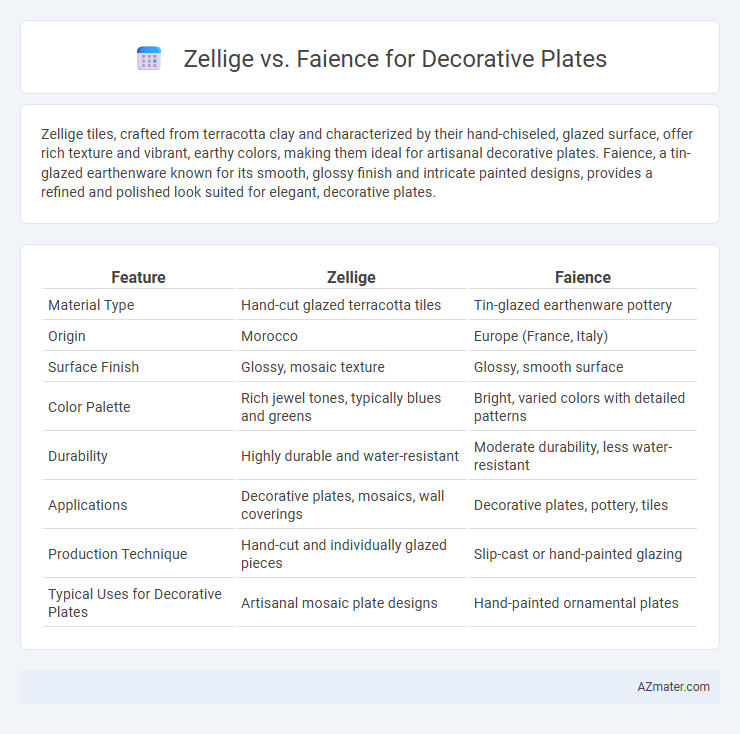Zellige tiles, crafted from terracotta clay and characterized by their hand-chiseled, glazed surface, offer rich texture and vibrant, earthy colors, making them ideal for artisanal decorative plates. Faience, a tin-glazed earthenware known for its smooth, glossy finish and intricate painted designs, provides a refined and polished look suited for elegant, decorative plates.
Table of Comparison
| Feature | Zellige | Faience |
|---|---|---|
| Material Type | Hand-cut glazed terracotta tiles | Tin-glazed earthenware pottery |
| Origin | Morocco | Europe (France, Italy) |
| Surface Finish | Glossy, mosaic texture | Glossy, smooth surface |
| Color Palette | Rich jewel tones, typically blues and greens | Bright, varied colors with detailed patterns |
| Durability | Highly durable and water-resistant | Moderate durability, less water-resistant |
| Applications | Decorative plates, mosaics, wall coverings | Decorative plates, pottery, tiles |
| Production Technique | Hand-cut and individually glazed pieces | Slip-cast or hand-painted glazing |
| Typical Uses for Decorative Plates | Artisanal mosaic plate designs | Hand-painted ornamental plates |
Introduction to Zellige and Faience
Zellige is a traditional Moroccan mosaic tile crafted from terracotta clay, renowned for its intricate geometric patterns and vibrant, hand-glazed finishes that create a unique, textured surface ideal for decorative plates. Faience, originating from French tin-glazed pottery, features a smooth, glossy surface with painted designs often inspired by Renaissance and Islamic art, making it popular for decorative plates with detailed imagery. Both materials offer distinct aesthetic qualities: Zellige provides a tactile, artisanal appeal, while Faience emphasizes refined, colorful illustrations.
Historical Origins and Cultural Significance
Zellige tiles, originating from 10th-century Morocco, are renowned for their intricate geometric patterns crafted through hand-cut terracotta pieces glazed in vibrant colors, reflecting Islamic art and Andalusian influence. Faience, with roots tracing back to 9th-century Faenza, Italy, features tin-glazed earthenware known for its smooth, opaque white surface adorned with painted motifs inspired by Renaissance and Baroque styles. Both Zellige and Faience hold significant cultural value, with Zellige symbolizing Moroccan architectural heritage and spiritual symbolism, while Faience represents European ceramic tradition and decorative artistry.
Artistic Techniques and Production Methods
Zellige employs intricate hand-cut terracotta tiles assembled into geometric mosaic patterns using traditional Moroccan craftsmanship, emphasizing detailed inlay and vibrant glazes. Faience is characterized by tin-glazed earthenware with painted motifs applied on smooth surfaces, relying on a single firing process that highlights colorful, often floral or figurative designs. The artistic techniques in Zellige focus on precision and repetition of shapes, while Faience prioritizes brushwork and pictorial decoration, reflecting different cultural aesthetics and production methods.
Materials Used in Zellige and Faience
Zellige is crafted from natural clay, shaped into intricate geometric tiles, and glazed with mineral-based pigments that produce a rich, earthy palette. Faience, on the other hand, utilizes a fine earthenware base coated with a tin-glaze that yields a smooth, glossy surface ideal for vibrant colors and detailed designs. The distinct materials in Zellige provide a textured, artisanal feel, while Faience offers a sleek, polished finish suitable for decorative plates.
Aesthetic Differences: Colors, Patterns, and Motifs
Zellige tiles showcase vibrant, glazed colors with intricate geometric patterns rooted in Moroccan craftsmanship, offering a richly textured and artisanal aesthetic for decorative plates. Faience features smoother surfaces with painted motifs, often floral or classical, reflecting European influences and a more delicate, refined elegance. The tactile complexity and bold color contrasts of Zellige create a striking visual impact, while Faience emphasizes subtlety and detailed imagery in its decorative appeal.
Durability and Functional Qualities
Zellige tiles, crafted from natural clay and fired at high temperatures, offer exceptional durability and resistance to moisture, making them ideal for decorative plates exposed to humidity or frequent handling. Faience, a glazed ceramic with a tin-based opaque coating, provides vibrant color options but is more prone to chipping and less resistant to wear. When prioritizing long-term functionality and robustness in decorative plates, Zellige outperforms Faience due to its sturdier composition and enhanced surface toughness.
Applications in Decorative Plates
Zellige and faience both offer unique aesthetic qualities for decorative plates, with zellige featuring intricate, hand-cut glazed terracotta tiles that create vibrant, geometric patterns ideal for traditional and Moroccan-inspired designs. Faience, a tin-glazed pottery style, provides a smooth, glossy surface with detailed painted motifs, making it suitable for intricate, colorful illustrations and classic European decorative plates. Applications of zellige emphasize texture and mosaic artistry, while faience focuses on detailed pictorial decoration and a refined finish.
Maintenance and Care Requirements
Zellige tiles, made from hand-cut Moroccan clay, require regular sealing to protect their porous surface from stains and moisture, making maintenance more intensive than faience. Faience, a glazed ceramic with a smooth, non-porous finish, offers easier cleaning and greater resistance to water and stains, ideal for decorative plates exposed to frequent handling or display. Both materials benefit from gentle, non-abrasive cleaning products to preserve their intricate designs and vibrant colors.
Cost and Accessibility Comparison
Zellige tiles, crafted from terracotta and hand-glazed with intricate patterns, tend to be more expensive than faience, reflecting the labor-intensive artisanal process and limited production primarily in Morocco. Faience, a tin-glazed earthenware known for its glossy finish and mass production in Europe, offers a more affordable and widely accessible option for decorative plates. Cost-effectiveness and availability make faience plates ideal for budget-conscious buyers, while collectors often value zellige plates for their unique craftsmanship and cultural authenticity.
Choosing Between Zellige and Faience for Your Decor
Zellige tiles, known for their handmade, geometric patterns and vibrant glazes, add a unique, artisanal touch to decorative plates, perfectly suited for Mediterranean or Moroccan-inspired interiors. Faience, with its smooth, tin-glazed ceramic surface, offers a more polished and colorful aesthetic, ideal for classic or French country decor styles. Choosing between Zellige and Faience depends on whether you prefer the rustic, textured authenticity of Zellige or the glossy, detailed artistry of Faience for your decorative plate.

Infographic: Zellige vs Faience for Decorative Plate
 azmater.com
azmater.com